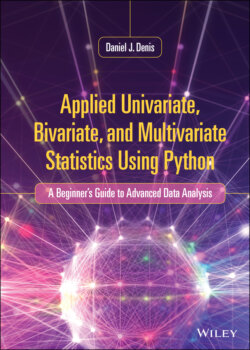Читать книгу Applied Univariate, Bivariate, and Multivariate Statistics Using Python - Daniel J. Denis - Страница 26
Review Exercises
Оглавление1 Discuss what is meant by an “axiom” in mathematics, and why such axioms are important to building the structure of theoretical and applied statistics.
2 Explore whether you consider probability to be a relative frequency or degree of belief. How would you define probability? Why would you define it in this way? Explain.
3 Summarize the overall purpose of inferential statistics. What is the “big picture” behind why statistical inference is necessary, even in the age of “big data?”
4 Why and how are measurement issues so important in science? How does this importance differ, if at all, between sciences such as physics and biology vs. psychology and economics? What are the issues at play here?
5 Explore whether self-reports actually tell you anything about what you are seeking to measure from an individual. Can you think up a situation where you can have full confidence that it is a valid measure? Can you think up a different situation where a self-report may not be measuring the information you seek to know from a research participant? Explain and explore.
6 Brainstorm and highlight a few of the measurement issues involved in the COVID-19 pandemic. What are some ways in which statistics could be misleading in reporting the status of the pandemic? Discuss as many of these as you can come up with.
7 Give a description and summary of how null hypothesis significance testing works and use a COVID-19 example in your discussion as an example to highlight its concepts and logic.
8 Distinguish between a type I and type II error and explain why virtually all decisions made in science have error rates. Which error rate would you consider the most important to minimize? Why?
9 Distinguish between point estimation and a confidence interval. Theoretically at least, when does a confidence interval become a point estimate?
10 Why is a basic understanding of the philosophy of science mandatory knowledge for the student or researcher in the applied sciences? Why is simply learning statistics and research design not enough?
11 Distinguish between deductive logic and inductive logic. Why is science necessarily inductive?
12 Explore and discuss why causation can be such a “sticky” topic in the sciences. Why is making causal statements so difficult if not impossible? Use an example or two in your exploration of this important issue.
13 Distinguish between a continuous vs. a discrete variable. Why is continuity in a research variable controversial? Explain.
14 How is it the case that numerical differences do not necessarily translate to equivalent differences on the physical variable being measured? Explore this issue with reference to scales of measurement.
15 Explore differences that may exist between data analysis, data science, machine learning, and big data. What might be the differences between these areas of investigation?
